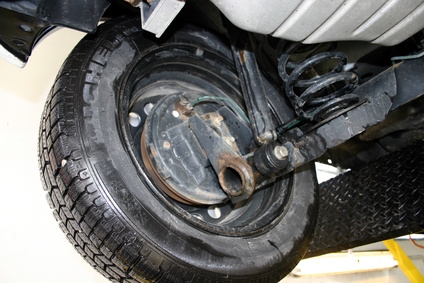
Independent suspensions offer two benefits over traditional straight-axle suspensions. The first is that movement of one wheel doesn't affect the other, so all wheels stay as plated as possible at all times. The second is that an independent suspension doesn't carry the dead mass of a differential, meaning that it can react faster to imperfections in the road. Independent rear suspensions (IRS) are used in the best-preforming vehicles on the planet.
Double wishbone suspensions (so called because they use an upper and lower wishbone-shaped control arm) are based on the earliest front suspensions. Double wishbones are widely using for front suspensions and others that require steering because they're easily incorporated with ball joints. Double wishbones are sturdy, versatile and don't cause camber (wheel tilt change) the way MacPherson struts do, but they're heavier and are more difficult to adjust than other designs.
Trailing arm suspensions are most often used for solid axle setups but have been adapted to work for independents (to the point that they've actually evolved into another type). A trailing arm is so called because it attaches to the chassis just ahead of the wheel and attaches to the wheel hub at one or two points (two-point suspensions are called semi-trailing suspensions). Trailing are suspensions are not often used for independent rear-wheel drive; the design is better suited to suspending either a solid axle or the rear of a front-wheel-drive car.
Multipoint suspensions evolved from both trailing arm and wishbone suspensions. Multilink suspensions resemble trailing arms in that they connect to the chassis ahead of the wheels (utilizing a top and bottom trailing arm called a "link"), but many differ in that they also use a set of links that tie into the chassis behind the wheel hub. Such suspensions are among the most supple and sophisticated on earth and lend themselves to almost infinite adjustability in all directions.
Trailing multipoints (also called semi-trailing multilinks) are more related to trailing arms than wishbones. Trailing multipoints (often incorrectly referred to as "4-links" in aftermarket parlance) use just the first two links of the true multipoint, but those links are very hefty and well-secured. Almost all trailing multilinks (as used on rear-wheel drive, independent suspension cars) are actually 3-link suspensions that include two links per side and a third rear or front link to keep the wheels pointed straight. This design in very popular for drag-race oriented cars like the Chevrolet Corvette, since it give excellent weight transfer and traction off the line (though technically the Corvette's suspension might be considered a four link if only because the leaf spring connects the the wheel hubs). Handling isn't as flexible as a true multipoint, but it's leagues ahead of the trailing arm and is at least comparable to the double wishbone.